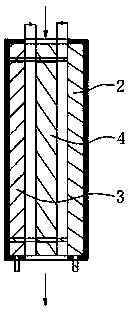Washing power-assisting device
A technology of a booster device and a washing device, applied in the field of washing, can solve the problems of weak washing power, easy failure, difficult maintenance, etc., and achieve the effects of reducing chemical residues and pollution, improving reaction efficiency, and increasing contact area.
- Summary
- Abstract
- Description
- Claims
- Application Information
AI Technical Summary
Problems solved by technology
Method used
Image
Examples
Embodiment 1
[0050] For the washing booster device of this embodiment, see figure 1 , including an electrolysis power supply and a water quality adjustment unit 20 arranged outside the existing washing device 10 . One of the water inlets of the water quality adjustment unit 20 communicates with the external water supply pipe 40 , and the water outlet of the water quality adjustment unit 20 communicates with the water injection port of the washing device 10 .
[0051] A water pump 30 is also provided between the water inlet of the washing device 10 in this embodiment and the second water inlet of the water quality adjustment unit 20 . A filter screen 50 and a drain valve 60 are provided between the water inlet of the washing device 10 in this embodiment and the water pump 30 . The washing device 10 of this embodiment may be a washing machine, a fruit and vegetable washing machine and other washing equipment.
[0052] Such as figure 2 with image 3 As shown, the water quality adjustment...
Embodiment 2
[0087] The washing booster device of this embodiment is basically the same as that of Embodiment 1, as Figure 4 with Figure 5 As shown, the change different from Embodiment 1 is: the water quality adjustment unit 20 includes an anode 3 and two cathode electrodes 2 placed parallel to each other and vertically, and an anode 3 is arranged between the two cathode electrodes 2 to form two For the interacting cathode electrode 2 and anode electrode 3, the two sides of the anode electrode 3 are closely attached to the water-permeable membrane 4, and the distance between each water-permeable membrane 4 and the adjacent cathode electrode 2 is 1 mm.
[0088]For checking the washing effect of the present embodiment unit device, carried out following test:
[0089] 1) The external docking washing device is a commercially available Xiaoya brand mini washing machine (XPB30-40D). The water inlet and outlet of the water quality adjustment unit and the washing machine form a closed water su...
Embodiment 3
[0097] The washing booster device of this embodiment is basically the same as that of Embodiment 1, and the changes different from Embodiment 1 are: 1) the anode electrode 3 is an inert electrode made of carbonaceous materials such as graphite and activated carbon; 2) the water-permeable diaphragm 4 is A single-layer water-permeable diaphragm made of carbonaceous materials such as graphite and activated carbon; 3) The distance δ between the water-permeable diaphragm 4 and the positive electrode 3 1 is 0.5mm; 4) The distance δ between the water-permeable diaphragm 4 and the cathode electrode 2 2 8mm; 5) Both ends of the water-permeable diaphragm 4 respectively exceed the cathode and anode electrodes by a small section.
PUM
| Property | Measurement | Unit |
|---|---|---|
| pore size | aaaaa | aaaaa |
| pore size | aaaaa | aaaaa |
| pore size | aaaaa | aaaaa |
Abstract
Description
Claims
Application Information
 Login to View More
Login to View More - R&D
- Intellectual Property
- Life Sciences
- Materials
- Tech Scout
- Unparalleled Data Quality
- Higher Quality Content
- 60% Fewer Hallucinations
Browse by: Latest US Patents, China's latest patents, Technical Efficacy Thesaurus, Application Domain, Technology Topic, Popular Technical Reports.
© 2025 PatSnap. All rights reserved.Legal|Privacy policy|Modern Slavery Act Transparency Statement|Sitemap|About US| Contact US: help@patsnap.com



